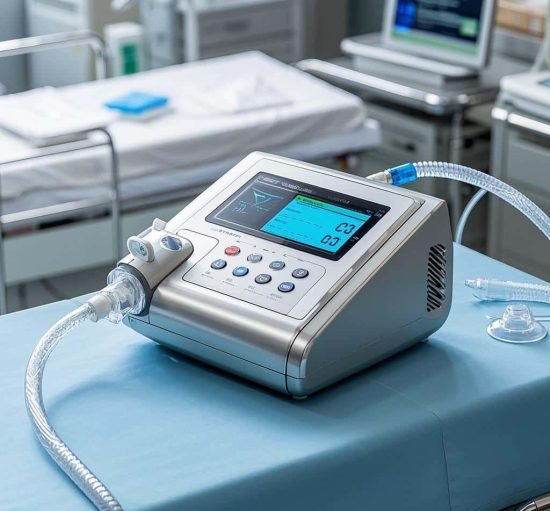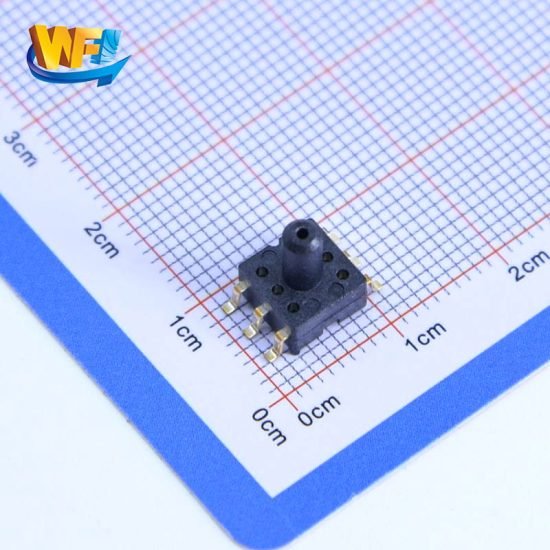목록
High-precision MEMS negative pressure sensors convert minute diaphragm deflections into electrical signals via capacitive or strain-gauge detection, achieving resolutions down to 10 Pa and nonlinearity below 0.01 % FS in a 0–50 kPa range. Silicon–glass anodic bonding and stress-relief structures ensure hermeticity and minimize thermal stress, yielding stability within ±20 ppm/°C and response bandwidths exceeding 100 kHz. This article presents operating principles, structural design, key performance metrics, installation and welding best practices, pre-production testing tools and methods, and application scenarios—equipping engineers and customers with a reliable, high-value solution for precise negative-pressure data acquisition.
Operating Principle and Structure
Diaphragm & Microcavity Mechanics
A thin silicon or metal diaphragm spans a sealed microcavity; when internal pressure falls below external reference, the diaphragm flexes inward, with displacement roughly linear to negative pressure. Deep reactive ion etching (DRIE) and photolithography define cavity dimensions with submicron precision, ensuring full-scale linearity without residual plastic deformation.
Capacitive vs. Strain-Gauge Detection
In capacitive designs, diaphragm motion changes electrode spacing and thus capacitance, which a precision bridge converts to a voltage signal. Strain-gauge types pattern metallic foil resistors on the diaphragm; bending alters resistance, measured via a Wheatstone bridge for high sensitivity and noise immunity.
포장 & Stress Isolation
Hermetic sealing employs silicon–glass anodic bonding or low-temperature ceramic bonding to balance vacuum integrity and manufacturability. Internal support pillars or flexible adhesives decouple PCB flexure and thermal expansion stresses from the diaphragm, preserving measurement fidelity.
Thermal Stability & 대역폭
The diaphragm’s low mass yields intrinsic bandwidths beyond 100 kHz, capturing rapid pressure transients in microsecond timescales. On-chip temperature sensors feed digital compensation algorithms that constrain zero-point and sensitivity drift to below ±20 ppm/°C.
주요 성과 지표 & 형질
정확성 & 해결
Top-tier MEMS negative-pressure sensors achieve overall accuracy of ±0.1 % FS and minimum resolution of 0.01 % FS, enabling detection of sub-0.01 kPa pressure changes.
선형성 & Hysteresis
Optimized diaphragm geometry and readout circuitry limit linearity error to ≤±0.05 % FS and hysteresis to ≤±0.02 % FS, ensuring consistent readings during increasing and decreasing pressure cycles.
온도 드리프트 & Long-Term Stability
Silicon–glass packaging and stress-buffering structures reduce thermal stress; combined with digital temperature compensation, zero-point and sensitivity drift stay within ±20 ppm/°C, and 5 000 h of accelerated aging tests show <±0.1 % FS drift.
Response Speed & Overload Protection
With response times <10 µs and bandwidths >100 kHz, these sensors excel in fast-transient applications such as medical ventilation. Mechanical stops or diaphragm hard stops typically protect against overpressure up to 200 % FS.
전력 소비 & Interfaces
Operating currents under 10 mA (power <30 mW) and flexible outputs—analog (0.5–4.5 V), I²C, SPI—permit easy integration with MCUs, PLCs, or DCS for closed-loop control.

설치 & Welding Considerations
Environmental Preparation & Protection
Install sensors away from heavy vibration and corrosive atmospheres; maintain ambient temperatures between –40 °C and 85 °C. Replaceable filters keep particulate and moisture out while allowing airflow.
Low-Heat Welding Methods
Use infrared reflow or laser welding to concentrate heat locally and minimize exposure time. Select no-clean, halogen-free solder pastes to reduce corrosive residues that can degrade sensor packaging.
PCB Layout & Stress Isolation
Limit PCB and component heights to reduce board flexure; include soft mounting pads or flexible supports under the sensor to absorb mechanical and thermal stresses.
ESD Precautions & Cleaning
Handle sensors with grounded ESD protection. Pre- and post-solder cleaning with isopropyl alcohol removes flux residues and prevents long-term contamination.
Pre-Production Testing & Measurement
Calibration Lab Setup
Employ high-precision gas modules (adjustable to ±0.01 Pa) with vacuum and pressure pumps in a closed-loop bench to establish stable reference pressures.
Multi-Point Calibration & Traceability
Use NIST-traceable dead-weight testers or precision manometers to perform at least five-point calibration (zero, full-scale, and intermediate points), logging zero-point, sensitivity, linearity, and hysteresis data for each sensor.
Automated Data Acquisition & SPC
Integrate 24-bit ADCs with LabVIEW or Python scripts to capture pressure-output curves in real time. Apply Statistical Process Control (SPC) to monitor batch performance, control Cpk, and maintain yields ≥98 %.
Environmental & Aging Tests
Subject sensors to thermal cycling (–40 °C to 85 °C) and humidity stress tests (THB) to evaluate drift, then conduct Highly Accelerated Life Testing (HALT) to uncover latent failure modes and refine design.
응용 프로그램 시나리오 & Customer Value
Medical Ventilation & Suction
Accurate negative-pressure sensing in ventilators and suction devices prevents over-suction injuries and ensures patient safety via automatic pressure regulation.

공조 & Negative-Pressure Isolation
Monitoring room pressure in healthcare facilities, labs, and cleanrooms prevents cross-contamination and optimizes energy efficiency by balancing intake and exhaust flows.

Industrial Vacuum & Microfluidics
In vacuum packaging, semiconductor processing, and lab-on-a-chip systems, precise negative pressure control ensures uniform coating, packaging integrity, and reproducible microfluidic flows.

Research & Emerging Technologies
High-resolution negative pressure data support innovations in micro-nasal flow studies, biochip development, and aerodynamic testing, accelerating lab discoveries toward commercialization.
결론
By dissecting the principles, structure, performance, installation practices, pre-production testing, and diverse applications of high-precision MEMS negative pressure sensors, this guide delivers a customer-centric roadmap for implementing reliable, accurate, and robust negative pressure measurement solutions.
위의 소개는 압력 센서 기술 적용의 표면적인 부분에 불과합니다. 우리는 다양한 제품에 사용되는 다양한 유형의 센서 요소, 작동 방식, 장점과 단점을 계속해서 탐구할 것입니다. 여기에서 논의된 내용에 대해 더 자세히 알아보려면 이 가이드 뒷부분의 관련 콘텐츠를 확인하세요. 시간이 촉박한 경우 여기를 클릭하여 이 가이드의 세부정보를 다운로드할 수도 있습니다. 공기 압력 센서 제품 PDF 데이터.
다른 센서 기술에 대한 자세한 내용은 다음을 참조하십시오. 센서 페이지를 방문하십시오.

